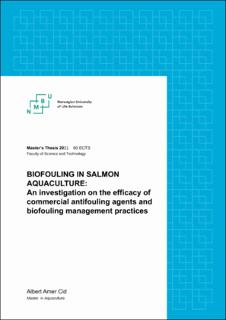| dc.description.abstract | With the recent growth and development of the salmon farming industry, associated environmental impacts and challenges have also risen. The settlement and growth of unwanted organisms on the submerged structures of the fish farms has become one of the main problems in the Norwegian and global salmon aquaculture industry. The use of copper-based biocidal antifouling coatings for the sea cages is the primary method used against the development of biofouling. However, the use of these antifouling paints is linked with marine pollution and high economic costs. Thus, understanding the biofouling development process, finding competitive alternatives to copper coatings, maximising the
efficiency of coatings and improving the biofouling management practices, are some of the most current relevant aspects for the salmon aquaculture industry, both economically and environmentally.
This field study compared the efficacy of seven commercial anti-fouling coating treatments applied to standard nylon netting and an alternative netting material of higher mesh breaking strength (Plateena NEO) immersed at three different depths (2, 10 and 25 m) during the winter - spring period at a salmon farm in western Norway. The development of biofouling was quantified by monthly image analysis measurements for the percentage net occlusion (PNO) and the identification of the main taxonomic groups present. An automatic image analysis code was developed to facilitate the image processing. This proved to be successful, and could potentially be used in future studies or as a stepping stone for the further development of biofouling quantification tools. The experience from this project highlighted the importance of lightning conditions, background to foreground contrast and standardized methods during the image sampling, for the proper estimation on the occlusion levels of the nets.
After five months of immersion (December - May), results show that all of the coating treatments vastly outperformed the untreated control nets. However, no major operationally relevant differences in occlusion levels and species compositions were found among the tested coatings and netting materials. Per contra, the composition of the fouling communities and the occlusion rates varied with depth, as biofouling growth decreased as the depth increased. Due to the low biofouling pressure encountered, longer testing and under higher biofouling pressure are necessary to further estimate the performance of the antifouling agents and net types. | en_US |

